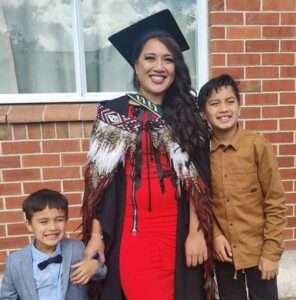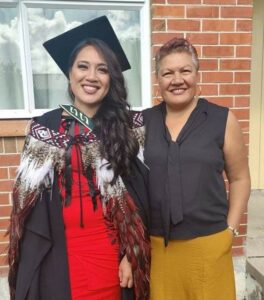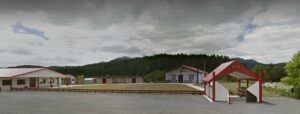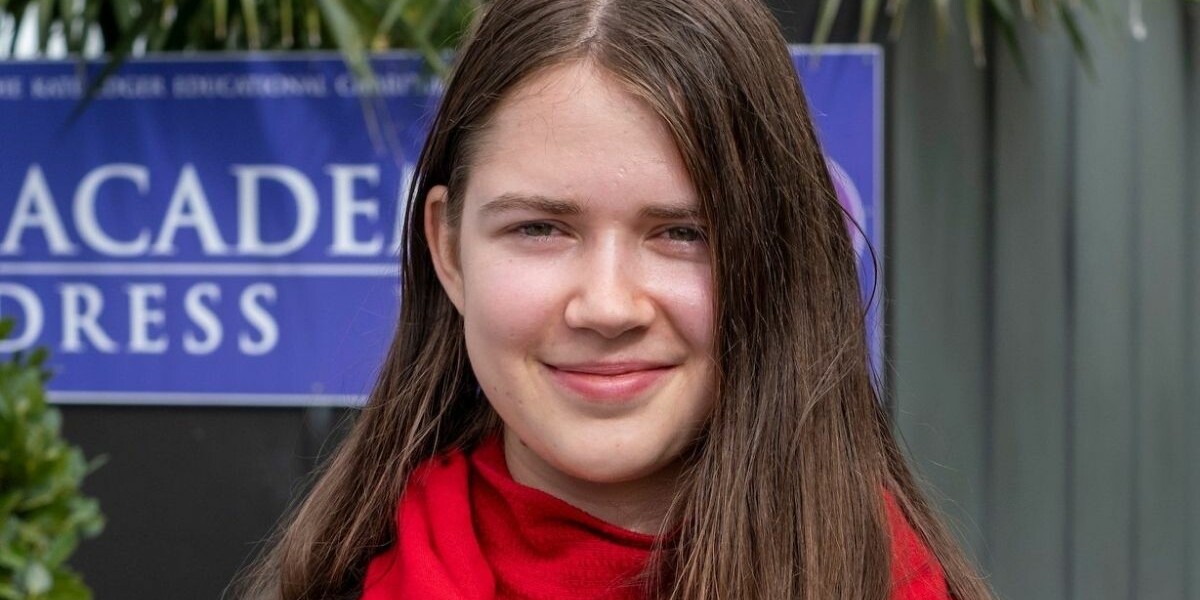Abridged from an article originally published by the Unitec Media Team, June 2022
 Bachelor of Architecture graduate and Ngā Wai A Te Tūī researcher Keisha Rawiri (Ngāti Hine, Ngāti Hāmoa) pictured on the left with her mother, has been awarded one of The KEECT Master’s Awards valued at $8000 to help fund her Master of Architecture (Professional) Project supporting the regeneration of the Tau Henare Marae in Te Taitokerau (Northland).
Bachelor of Architecture graduate and Ngā Wai A Te Tūī researcher Keisha Rawiri (Ngāti Hine, Ngāti Hāmoa) pictured on the left with her mother, has been awarded one of The KEECT Master’s Awards valued at $8000 to help fund her Master of Architecture (Professional) Project supporting the regeneration of the Tau Henare Marae in Te Taitokerau (Northland).
KEECT Awards Coordinator Katrina Ford says Keisha’s hard work and determination to succeed combined with dedication to her whānau and community epitomizes the values of the Trust. “What made her application special compared to the many other excellent applications is how her referees spoke about how Keisha supports her colleagues and fellow students, despite her many commitments. The application process for the Master’s Degree Awards is very competitive. This is the first time a student from Unitec has received one of our Master’s Awards, so we hope that Keisha’s success will encourage other Unitec students to apply.”
It is a significant milestone for Keisha, who took up her studies as a mature student to pursue her dream as a teenager of becoming an architect. She says that her interest sprang from a keen interest in art and having an analytical brain. “I figured architecture was a great way to put them together, but my high school didn’t have the resources or the programmes to support jumping into architecture at the time”.
After leaving school, she moved to Australia and ‘life happened’. She pursued a career in banking and finance for 8 years alongside having her family, before deciding it was time to finally follow her dream of becoming an architect.
“The KEECT were also part of my beginning architectural studies journey. In my first year, I applied to them for a scholarship to start my studies and was awarded a $2000 Tressa Thomas Retraining award, which assists mature women to retrain in a profession.”
 “One of the big things for me was that I was born and raised Samoan. I grew up with a solo mother who returned to study as a mature student. My mother modelled age should never be an obstacle to further education. I also grew up surrounded by my nana and grandpa, who were fluent in Samoan and ensured that my Samoan identity was strong. Unfortunately, I didn’t have an established relationship with my father, who is Māori. Then I had this reconnection with my whakapapa on his side that sprang from an internship with Matakohe Architecture and Urbanism in Whangārei during the second year of my Bachelor’s Degree”
“One of the big things for me was that I was born and raised Samoan. I grew up with a solo mother who returned to study as a mature student. My mother modelled age should never be an obstacle to further education. I also grew up surrounded by my nana and grandpa, who were fluent in Samoan and ensured that my Samoan identity was strong. Unfortunately, I didn’t have an established relationship with my father, who is Māori. Then I had this reconnection with my whakapapa on his side that sprang from an internship with Matakohe Architecture and Urbanism in Whangārei during the second year of my Bachelor’s Degree”
Keisha’s Master’s project represents an extremely significant journey of connection on both a professional and personal level.
“Through the internship journey, I visited my marae and participated in their Waimā Waita Waiora wānanga, staying two nights. That was about caring for our wai and protecting the life of tuna (eel), which has a significant role in our hapū narratives. Through that, I connected with my extended whānau on my father’s side and that’s where my journey started. ”

Through discussion with whānau, one of the aspirations that initiated the research project was to breathe life back into Ngā Tau e Toru, the original wharenui of Tau Henare marae built in 1893, before the larger Tau Henare whare tupuna was built in the mid-19th century.
For a long time, it housed the Kōhanga Reo, with koro and kuia sharing knowledge with mokopuna with te reo, but over the years natural wear and tear meant it became unsafe for whānau use. Eventually, it was disestablished as a functioning whare on the marae and now sits vacant and unutilised.
“As a research project, it is quite special because through the process of whakawhanaungatanga and as the researcher, because of my whakapapa connection, I share a strong relationship with the people and the place and further expresses the Kaupapa Māori lens the research project is adopting. For Māori, whakapapa, history, and cultural narratives are passed down and Ngā Tau e Toru is part of the marae history, a precious taonga. It is about the narrative”
Keisha hopes that her project will provide the vision and scope for the original wharenui to be brought back to life, bringing the history of Nga Tau e Toru forward rather than sitting unutilised.
“Tau Henare marae whānau will receive the final report as a koha – as a thank you for their time and contribution. The hope is that they can use it as a design advocacy report to support the marae’s current and future aspirations. It will include a visual representation of Ngā Tau e Toru’s regeneration where hapū were in the driver’s seat, leading the visioning, aspirations, and design development.”
The Kate Edger Trust looks forward to following and supporting Keisha on her Master’s journey.
Related Posts
Lina Tangata-Tearetoa – Māori/Pasifika Midwifery Awardee
Meet Lina who is due to complete her Midwifery degree at the end of 2021
Maja Ranzinger – Engineering Awardee
Congratulations to AUT engineering student Maja Ranzinger who is the inaugural recipient of the…




